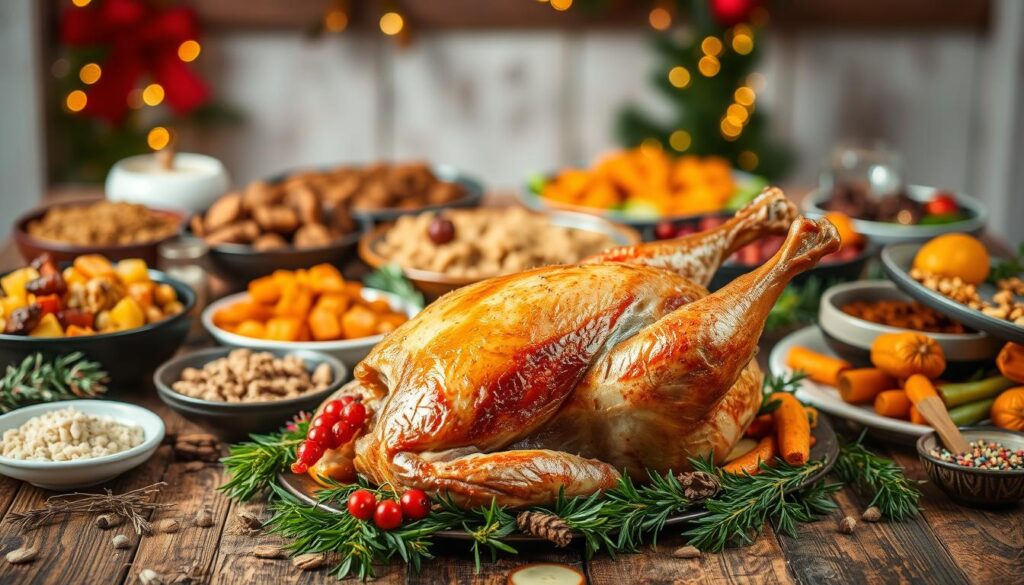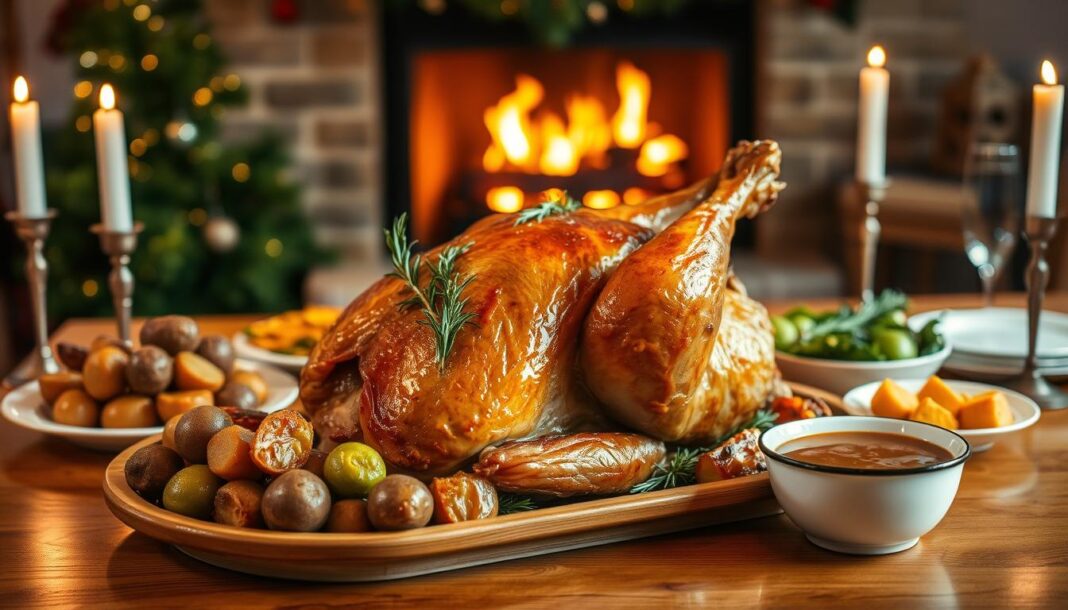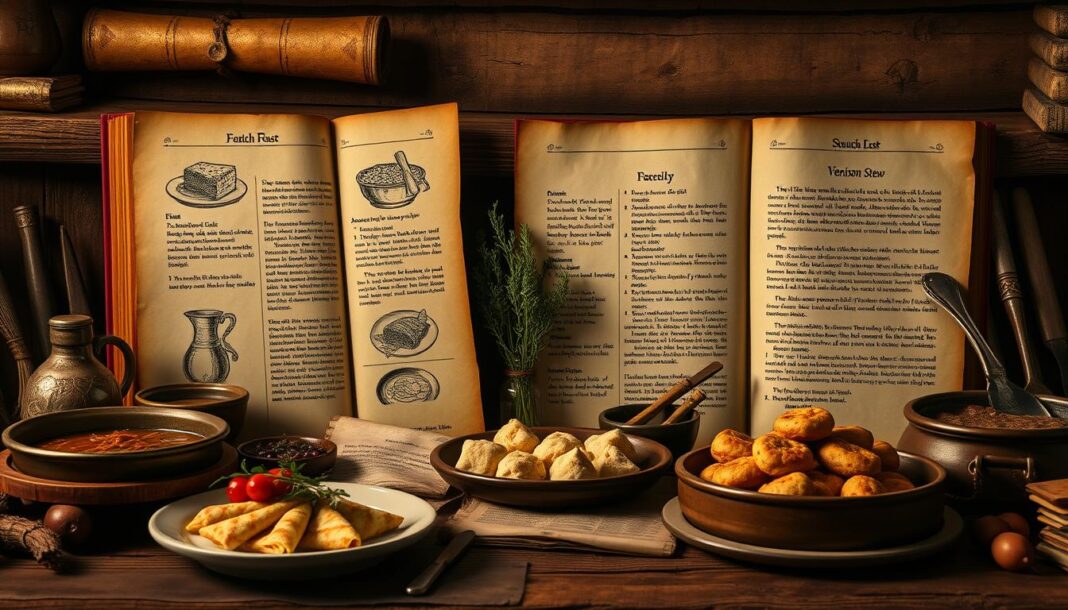For five years, we’ve perfected the art of preparing a roast goose—a dish that carries deep tradition and rich flavor. Our journey began with a less-than-perfect attempt, but through trial and error, we’ve crafted a foolproof recipe worth sharing.
Why choose goose over other holiday meats? Its natural richness and crispy skin set it apart. Plus, the rendered fat adds depth to side dishes like chestnut stuffing and red wine gravy.
Our method combines dry-brining and dual-temperature roasting for juicy, tender results. While the total prep time may seem long (up to 19 hours), active cooking requires just a fraction of that. The reward? A show-stopping centerpiece your guests will remember.
Why a Christmas Roast Goose Makes the Perfect Holiday Centerpiece
Ray’s family blended traditions—Hanukkah latkes and a Dickensian feast—around one centerpiece. Their story mirrors how this bird bridges cultures, from Victorian literature to modern holiday tables.
What sets it apart? The meat is richer than turkey, with a deeper flavor profile. Each serving packs 905 calories, including 74g of luxurious fat that melts into crispy skin and tender bites.
Here’s why chefs and families love it:
- Cultural Icon: Dickens’ “A Christmas Carol” cemented its festive status—yet it’s adaptable. Ray’s tree-trimming compromise (a menorah nearby) shows how it unites traditions.
- Flavor Goldmine: Rendered fat elevates side dishes. Use it for roasted potatoes or fry latkes, just like Ray’s grandmother did.
- Effort-to-Reward Ratio: While roasting time spans hours, active prep is minimal. The result? A jaw-dropping centerpiece.
This isn’t just another recipe. It’s a heritage dish that turns meals into memories. Whether you’re honoring old customs or creating new ones, the Christmas Roast Goose delivers on every level.
Preparing Your Goose for the Oven
The secret to a flawless holiday centerpiece starts long before the oven preheats. Proper prep ensures crispy skin, juicy meat, and rendered fat for cooking. Follow these steps to avoid common pitfalls.
Selecting the Right Bird
Choose a 10–12 lb goose with intact skin—avoid pre-trimmed options. Smaller birds dry out; larger ones cook unevenly. Look for plump breasts and smooth, unbroken skin to guarantee optimal fat rendering.
Dry-Brining for Moisture and Flavor
Mix ½ cup Diamond Crystal salt with 2 tbsp baking powder. The alkaline powder breaks down skin proteins for crispness. Rub it evenly, then refrigerate uncovered for 6+ hours. This draws out moisture, which the salt reabsorbs for seasoned, tender meat.
Prepping the Skin and Cavity
Remove wingtips and the wishbone (check YouTube for tutorials). Pat the bird dry—any moisture steams instead of crisping. Here’s a pro tip: Skip tweezer marathons for vestigial quills. We learned they dissolve during cooking.
Blanch the goose in boiling water for 1 minute to jumpstart fat rendering. Dry thoroughly before roasting. Now, your bird is ready for the oven—next, we’ll master the roasting process.
Mastering the Roasting Process
The magic happens when heat meets fat—here’s how to control both for perfect results. Unlike poultry that relies on brines, this bird thrives on precise temperature shifts and strategic fat management. Follow our tested method to avoid soggy skin or uneven cooking.
Initial High-Heat Roasting
Start at 425°F (220°C) for 30 minutes—this blast of heat jumpstarts fat rendering and crisping. Place the bird breast-down on a V-rack to shield the delicate meat from drying out. Pro tip: Use a turkey baster to siphon off pooled fat every 20 minutes, preventing a greasy flood.
Managing the Fat: Tips and Tricks
Expect 2+ cups of rendered fat—save it for roasting potatoes or frying latkes. Here’s how to handle it like a pro:
| Issue | Solution |
|---|---|
| Excess fat in pan | Siphon with a baster; store in jars |
| Uneven crisping | Rotate pan halfway through cooking |
| Smoke point risk | Line the roasting pan with foil for easy cleanup |
Finishing at Low Heat for Perfect Doneness
After the initial blast, reduce the oven to 275°F (135°C). Flip the bird breast-up and roast until thighs hit 175°F (79°C)—they’ll rise to 185°F (85°C) during resting. Bonus hack: Deglaze the pan with Amontillado sherry for a sauce with caramelized depth.
Recipe Variations for Your Christmas Roast Goose
Transform your holiday feast with these expert-approved twists on classic accompaniments. We’ve tested every element—from stuffing to gravy—to ensure they complement the rich flavors of your centerpiece. Below, two standout recipe upgrades that marry tradition with innovation.

Classic Prune and Apple Stuffing
Swap basic breadcrumbs for sherry-soaked prunes and toasted chestnuts. Sauté diced onion in reserved goose fat until golden, then fold in cubed sourdough, thyme, and a pinch of pepper. The prunes add a caramelized sweetness, while chestnuts lend crunch.
Red Wine Gravy with Pan Juices
Our gravy method starts with a roux: Whisk 2 tbsp flour into ¼ cup rendered fat. Deglaze the pan with 2 cups bold red wine, scraping up browned bits. Add gelatin-enhanced stock (homemade or store-bought) and 1 tbsp tomato paste for umami depth. Simmer until glossy.
Pro tip: Reserve the liver—finely chop and stir into the gravy just before serving for a silky finish. Here’s how to troubleshoot common issues:
| Issue | Solution |
|---|---|
| Gravy too thin | Simmer longer or add a cornstarch slurry |
| Bitter aftertaste | Balance with a teaspoon of honey |
| Lumpy texture | Strain through a fine-mesh sieve |
Whether using homemade stock or store-bought, adjust salt levels gradually. The giblets (except liver) can simmer into the stock for extra richness. These tweaks turn familiar sides into unforgettable highlights.
Pairing Side Dishes with Roast Goose
The right sides transform a good meal into an unforgettable feast—here’s how to pair them perfectly. We’ve tested every combination to balance richness, texture, and flavor. These picks let the star shine while holding their own.
Double-Duty Fat Magic: Use rendered drippings for crispy potatoes. Par-cook Yukon Golds in salted water, then roast in fat at 400°F for 40 minutes. Toss with thyme and cracked pepper for a golden crust.
Brussels Sprouts Upgrade: Sauté pancetta in reserved fat until crisp. Toss with halved sprouts and roast 25 minutes. The saltiness cuts through the bird’s richness.
Tangy Counterbalance: A red cabbage slaw with apple cider vinegar and caraway seeds adds acidity. Shred cabbage thin—it softens without cooking, saving you an hour.
- Post-Holiday Hack: Use leftover fat for Hanukkah latkes. Grate russet potatoes finely, fry in spoonfuls, and top with applesauce.
- Wine Pairings: German Spätburgunder’s bright acidity complements the food. Prefer bolder flavors? Oregon Pinot Noir mirrors the dish’s depth.
Every side here serves a purpose—crisp, bright, or savory. Together, they turn a lot of effort into a seamless, showstopping spread.
Carving and Serving Your Christmas Goose Like a Pro
A perfectly roasted bird deserves equally skilled carving—here’s how to execute it flawlessly. We’ve tackled 11-pound birds and learned the hard way: rushing leads to torn meat and missed juices. Follow these steps to serve every slice with confidence.
Angled Breast Slicing: Use a sharp knife to cut thin, even slices against the grain at a 45° angle. Start from the wing joint toward the breastbone for maximal yield. This preserves tenderness and showcases the golden crust.
Jointing Tricks: Locate natural separations—the thigh and legs disconnect at ball-and-socket joints. Twist gently; if resistance persists, reposition your knife. Remove wings last by cutting through the shoulder cartilage.
Let the bird rest 30 minutes post-roast. This redistributes juices—skip it, and they’ll flood the pan. For show-stopping plating, layer slices over warm gravy. The heat revives the meat’s succulence.
| Challenge | Solution |
|---|---|
| Tough wishbone | Remove it pre-roast (YouTube tutorials help) |
| Dry breast | Slice thicker near the bone; thinner at the tip |
| Sticky skin | Chill the bird 20 minutes for cleaner cuts |
Don’t discard the carcass! Simmer it immediately with onions and herbs for a rich stock—ideal for next-day pho. The liver? Sauté it separately for a chef’s snack or blend into gravy.
Your Holiday Feast Awaits: Savor the Magic of Roast Goose
Great meals aren’t just about taste—they’re about the memories they create. Embrace imperfections; every messy attempt becomes family lore. We’ve learned that even unevenly crisped skin or over-reduced gravy sparks laughter—and stories for years.
This recipe bridges generations. Adapt it freely—swap prunes for figs, or use the rendered fat for candles. Ray’s menorah-lighting ritual, paired with this dish, shows how food unites traditions.
The first bite justifies every hour spent. Whether you’re gifting homemade stock or starting a new carving ritual, let this meal be your canvas. After all, the best feasts aren’t perfect—they’re alive with connection.


